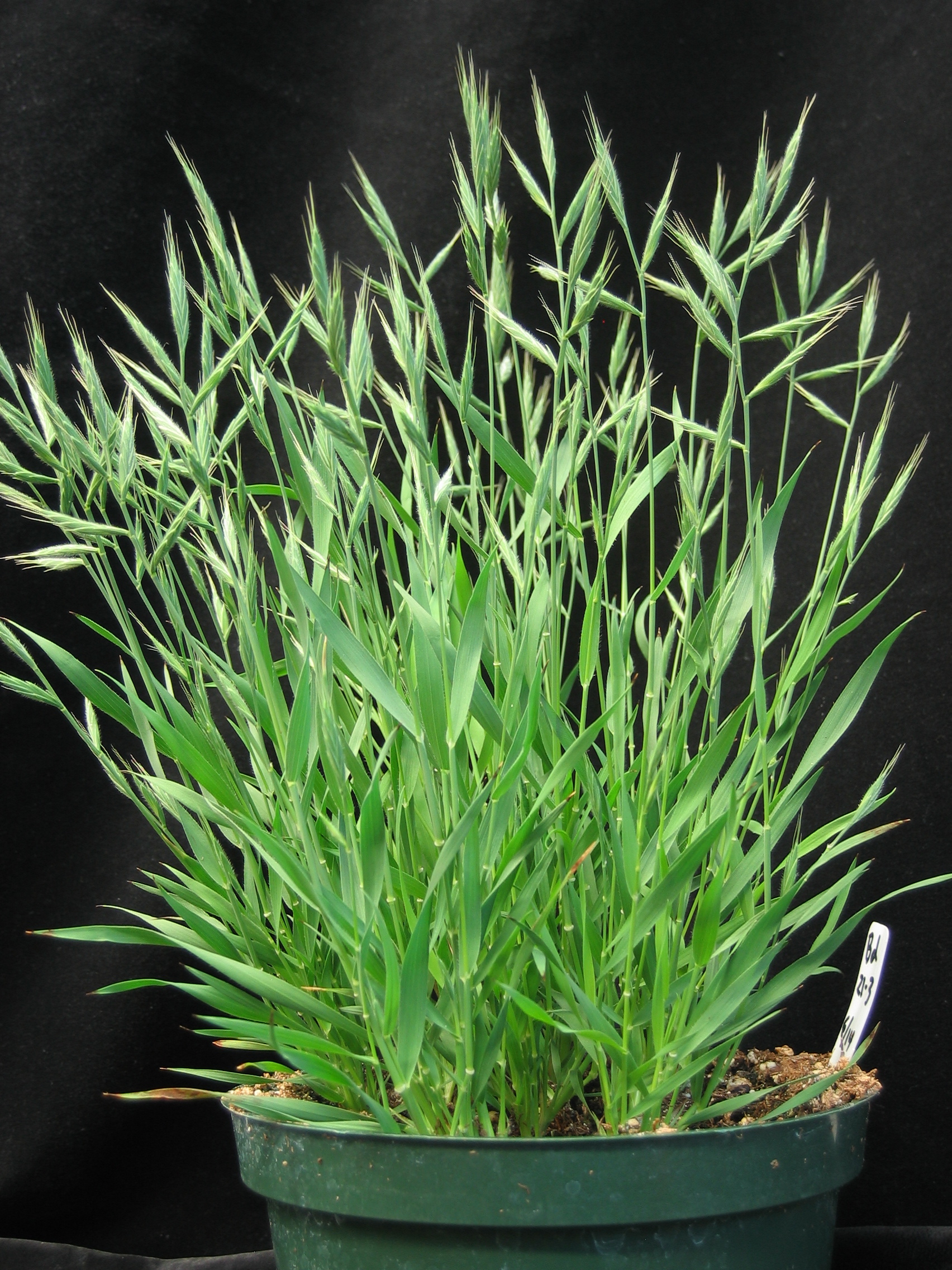Scientific Name: Brachypodium Distachyon
Common Name: Purple False Brome; Stiff Brome
Photos:


Line Drawing:

Morphological Description:
Flowers/Fruits:
Flowers 3 – 4 weeks without vernalization, or exposure of seeds to low temperature
Spikelet contains typically around 10–12 seeds
Often tinged purple
Leaves:
Stems are erect or flat with the tips turning upward, usually lacking hairs except at the densely hairy nodes.
Grass has short stature, can grow approximately 15 – 20 cm
Habitat & Basic Biology (life history, dispersal abilities):
Dry slopes and fields, roadsides, disturbed grassland, margins of shrub thickets
Tolerates thin rocky soil and partial shade in oak woodlands
Drought tolerant
Germination occurs primarily in fall or early winter after the first significant rain of the season
Self-fertile
Annual grass with short life cycle, from 8 – 12 weeks
Last three principal growth stages, comprising fruit development, ripening and senescence, occur over 4 weeks
Functional traits (photosynthetic rates, phenology, etc.):
Has one of the smallest genomes of the diploid grass genomes, diploid inbred line Bd21
Currently being used as a model monocotyledon for grass crop research and bioenergy grass biotechnology
A C3 producer, a plant in which CO2 is fixed into a compound containing three carbon atoms before entering the Calvin cycle of photosynthesis
Distribution (geographic range):
Native Range: Middle East, North Africa, Asia, and Southern Europe
Invasive Area: Common in California, but scattered throughout the other western states, including Oregon, Colorado and Texas. Australia, New Zealand, South Africa, North and South America (Bakker)
Control (evaluation of methods):
Small infestations can be controlled with hand pulling, mowing, or tillage
timing of mowing should be before viable seed production but after most soil moisture has been depleted to prevent regrowth.
Shallow cultivation shortly after the main flush of germination and again a little later can eliminate most seedlings
Prescribed burning in early summer shown to significantly reduce the population
Grazing has not been tested, but due to poor forage quality and low palatability, such a strategy would likely require short-duration, high-intensity grazing before seedhead production
Evolution (of traits in novel range):
Phylogenies indicate that B. distachyon split from the other species early in the evolution of the genus
Brachypodium has evolved to respond to a large range of temperatures
However, displays a definitive difference in temperature responsiveness depending on the developmental stage
H2A.Z-nucleosomes coordinate the sensitivity of Brachypodium to increased temperature during grain development
Performance of invader in CA (interactions with species native to S. CA):
Can form dense stands in some locations, particularly in oak woodlands
These near monotypic stands can reduce diversity and prevent native species from establishing
Moderate alteration of plant community composition
Natural enemies:
Granivorous ants
Butterfly Marbled Xenica, in larval stage
List of References:
Boden, Scott A. “Thermal Stress Effects on Grain Yield in Brachypodium Distachyon Occur via H2A.Z-nucleosomes.” GenomeBiology.com. National Center for Biotechnology Information. 25 June 2013. Web. 12 Mar. 2014.
Dr. Boden and his associates analyzed the thermal responses of several crops, focusing on Brachypodium distachyon, and investigated the role of H2A.Z-nucleosomes in coordinating the sensitivity of temperate grasses to increased temperature during grain development.
Cal-IPC. “Cal-IPC Plant Assessment Form.” Cal-IPC.org. California Invasive Plant Council, 03 Jan. 2007. Web. 12 Mar. 2014.
DiTomaso, Joseph, et al. 2013. Weed Control in Natural Areas in the Western United States. Weed Research and Information Center, University of California, Davis.
Dr. Joe DiTomaso of UC Davis compiled information on control methods for 340 species in 13 western states, including Brachypodium distachyon.
Field, Ross. “Marbled Xenica.” Butterflies: Identification and Life History. Melbourne: Museum Victoria, 2012. 174. Print.
Dr. Ross Field has a PhD in entomology and has published more than 100 publications on interests such as insect ecology and the ecology, biology and conservation of butterflies; in her research she has noted the natural enemies of Brachypodium distachyon.
Hogan, Michael C. “Brachypodium Distachyon.” EOL.org. Encyclopedia of Life, Dec. 2013. Web. 7 Mar. 2014.
Michael C. Hogan is a theoretical physicist who studies biophysics and models ecological systems; EOL.org is an organization dedicated to increasing awareness and understanding of living nature in an open, freely accessible digital resource.
Hong, Shin-Young, et al. Phenological growth stages of Brachypodium distachyon: codification and description. Weed Research. 24 July 2011. Web. 12 Mar. 2014.
Professor Hong and his associates performed phenological analysis on Brachypodium distachyon using a BBCH (Biologische Bundesantalt, Bundessortenamt and CHemische Industrie) scale, and investigated the growth stages and functional activities of the grass.
Opanowicz, Magdalena, et al. “Endosperm Development in Brachypodium Distachyon.” OxfordJournals.org. Journal of Experimental Botany, 10 Sept. 2010. Web. 12 Mar. 2014.
Professor Magdalena and her associates constructed a cellular and molecular map of domains within the developing Brachypodium endosperm, providing a detailed description of grain development.
Wolny, Elzbieta, et al. “Compact Genomes and Complex Evolution in the Genus Brachypodium.” Springer. 01 Apr. 2011. Web. 12 Mar. 2014.
Professor Wolny and her associates analyzed coding sequences of Brachypodium using cytogenetic and molecular techniques to identify genomic lineages.
Photography References (In order of appearance):
O’Conner, Devin. Brachypodium Distachyon. 2010. Photograph. UC Berkeley, Berkeley. James and the Giant Corn Genetics: Studying the Source Code of Nature. James Schnable, 11 Feb. 2010. Web. 7 Mar. 2014. <http://www.jamesandthegiantcorn.com/2010/02/11/why-to-celebrate-the-publication-of-the-brachypodium-genome/>.
Steve Hurst. Provided by ARS Systematic Botany and Mycology Laboratory. Israel.
Hitchcock, A.S. (rev. A. Chase). 1950. Manual of the grasses of the United States. USDA Miscellaneous Publication No. 200. Washington, DC. 1950
Calflora: Information on California plants for education, research and conservation, based on data contributed by public and private institutions and individuals, including theConsortium of Calif. Herbaria. [web application]. 2014. Berkeley, California: The Calflora Database [a non-profit organization]. (Accessed: Mar 07, 2014).
